2013
Autospeak-Straight Talk contains articles covering digital and social media marketing social communities and events marketing
Panda 4.1 expected to benefit SMBs creating quality content
Tags:
(Posted on Sep 28, 2014 at 01:10PM )
By Brafton Editorial
 Google confirmed yet another Panda update. This one’s being called 4.1, although technically it’s the 26th Panda update since the algorithm was released – and it’s expected to help small- to medium-sized businesses rank better in search results.
Google confirmed yet another Panda update. This one’s being called 4.1, although technically it’s the 26th Panda update since the algorithm was released – and it’s expected to help small- to medium-sized businesses rank better in search results.About 3 to 5 percent of queries are supposed to be impacted, so companies publishing useful and creative content for their target audiences might already be feeling the positive impacts of this update with more organic search traffic.
News of the update and its effects comes straight from Google Webmaster Trends Analyst Pierre Far, who posted about the update on Google+ September 25, saying:
“Earlier this week, we started a slow rollout of an improved Panda algorithm … we’ve been able to discover a few more signals to help Panda identify low-quality content more precisely. This results in a greater diversity of high-quality small- and medium-sized sites ranking higher.â€
Far explained that since the Panda 4 update in May, Google has discovered new signals that make it easier to identify low-quality content. Thus, smaller sites putting out good web content have a better chance of ranking well for related searches.
“This results in a greater diversity of high-quality small- and medium-sized sites ranking higher.†– Google’s Pierre Far
While SMBs are poised to benefit from this update if they’re using transparent white hat optimization practices, many businesses are feeling the sting of a penalty.
Earlier this week, Brafton covered an update that punished sites using private blog networks to generate links and artificially build ranking signals. This shouldn’t necessarily come as a shock –Matt Cutts said guest blogging for links was so done you could stick a fork in it.
Reposted from Brafton

As the car becomes a connected Internet device, the titans of the tech sector are battling for control of the wheel.
The war is shaping up a lot like the computer sector, with Google, Apple and Microsoft and others fighting to be in control of the vehicle's "operating system" to deliver apps, navigation and other services.
Some of those battles were played out this week at the Consumer Electronics Show in Las Vegas, which included a record nine auto manufacturers and scores of equipment makers, including software and related tech companies.
"People want consumer apps in their cars, they want to connect to their smartphones, they want to connect to the cloud," says Grant Courville, director of product management at QNX, which makes the on-board systems used on tens of millions of cars.
But the battlefield is wide open because "there's no clear dominant app ecosystem in automotive," Courville told AFP from the CES floor.
At CES, Canadian-based QNX unveiled a partnership with Qualcomm to support the chipmaker's new automotive platform, which connects to smartphones and offers apps for maps, speech recognition, geolocation, and vehicle analytics.
At the same time, Google unveiled a partnership with General Motors, Audi, Honda and Hyundai in a new partnership to bring the Android mobile system to vehicles in a new Open Automotive Alliance.
The moves come with Microsoft in a longstanding partnership with Ford, and Apple widely expected to expand its system for connecting the iPhone with automotive electronics systems.
"Carmakers are conflicted," said Tim Tang, an analyst with IDC attending the Las Vegas expo.

Â
"They are trying to decide whether to build their own systems or partner with another company. If they partner, they mitigate a lot of the risk, but they give a lot away, looking at future services, like apps, pay-as you go insurance. No one is certain where it is going but carmakers don't want to be left out. The car is becoming a mobile accessory."
Tang said a key question for automakers is whether the cars should have a dedicated connection or use the smartphone.
"If it is a smartphone model, it's easy to get traction quickly, you don't need to design the system five years in advance. But if it is built into the car you have some advantages. If the car is stolen, for example, you can shut it off."
The General Motors division Chevrolet said this week it would deploy fourth generation (4G) Internet connections on several models to help motorists who want to stay connected with the growing number of apps for automobiles.
But compatibility issues in the nascent "infotainment" technology can mean some systems deliver apps from Android or Android but not both.
Mazda this week at CES announced a partnership with the US software firm OpenCar to launch a new standards-based app system that allows the on-board screen to act as a browser and use a wide range of applications on the Internet.
Paul Boyes, head of telematics and standards for Seattle-based OpenCar, said carmakers using the system would have more control of the apps, being able to choose those deemed safe for the road, and be able to draw from the full Internet, not just Android or Apple.
"With us, the carmakers are tied to a browser, not a company," he told AFP. "If you have Apple or Android, you are married to their system."

Â
Mazda staff manager Hideki Okano told AFP automakers are being forced to consider these new systems when designing vehicles, to keep up with what consumers are demanding.Tang said a key question for automakers is whether the cars should have a dedicated connection or use the smartphone.
"If it is a smartphone model, it's easy to get traction quickly, you don't need to design the system five years in advance. But if it is built into the car you have some advantages. If the car is stolen, for example, you can shut it off."
The General Motors division Chevrolet said this week it would deploy fourth generation (4G) Internet connections on several models to help motorists who want to stay connected with the growing number of apps for automobiles.
But compatibility issues in the nascent "infotainment" technology can mean some systems deliver apps from Android or Android but not both.
Mazda this week at CES announced a partnership with the US software firm OpenCar to launch a new standards-based app system that allows the on-board screen to act as a browser and use a wide range of applications on the Internet.
Paul Boyes, head of telematics and standards for Seattle-based OpenCar, said carmakers using the system would have more control of the apps, being able to choose those deemed safe for the road, and be able to draw from the full Internet, not just Android or Apple.
"With us, the carmakers are tied to a browser, not a company," he told AFP. "If you have Apple or Android, you are married to their system."

Â
"In the US market, infotainment and connectivity is becoming a major decision-making factor for car buying," Okano said. "It is also growing in other markets."
QNX's Courville said his firm, a unit of BlackBerry, is benefitting from the growth in new technologies, because it can deliver the overall platform which can interact with Android, Apple, and others.
"You need that battle-hardened system," he said. "We're the market leader in infotainment."
Even if carmakers want to use a system like Android, they still need to integrate into the car a system designed for smartphones and tablets.
"There's no automotive version of Android," he said, adding that QNX is a partner with Apple as well for automotive.
"We provide a framework and platform for automotive that is reliable and secure."
By Rob Lever
Explore further: Google partners with automakers for on-board Android
Meet Helpouts, Goolge's Secret Project That Turns Hangouts Into A Commerce Platform
Tags:
(Posted on Jul 26, 2013 at 02:23PM )
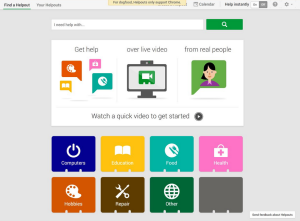 While its roots lie in search, today, Google wears many hats. From self-driving cars and wearable technology to social networking and mobile operating systems, there are few industries where the search and advertising giant has yet to make its presence felt. Lately, however, Google’s expansion has taken a noticeable tack in a more singular direction: e-commerce.
While its roots lie in search, today, Google wears many hats. From self-driving cars and wearable technology to social networking and mobile operating systems, there are few industries where the search and advertising giant has yet to make its presence felt. Lately, however, Google’s expansion has taken a noticeable tack in a more singular direction: e-commerce.With the outsized success Amazon and eBay have had building online marketplaces that seek to remove the barriers around buying and selling on the web, it was only a matter of time before Google decided to pull its chair up to the e-commerce table. Today, TechCrunch has learned via a tipster that Google has quietly been pursuing its marketplace ambitions under the auspices of a new platform that leverages its increasingly powerful cloud services to power live, real-time commerce.
The product, which has reportedly been named “Helpouts†and is currently being tested internally in Mountain View, will take shape as a marketplace that enables individuals and small and large businesses to buy and sell services via live video. With the capacity to connect merchants and consumers on both an immediate and scheduled basis, according to our tipster, the platform will allow sellers to create their own profiles and take advantage of reputation management, scheduling and payment features, while offering robust search and discovery tools for consumers.
Â
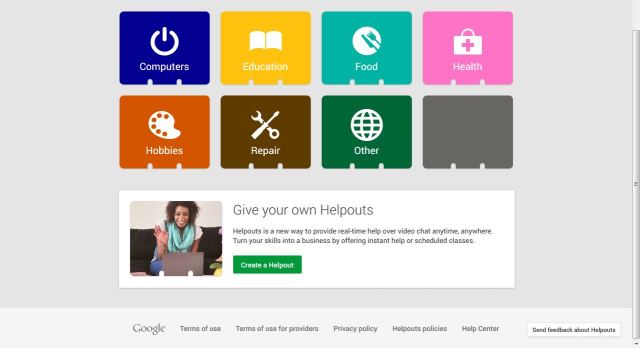
Â
As its live video infrastructure is increasingly becoming the unifying backend for its expanding roster of real-time products, Google’s new marketplace will leverage Hangouts to deliver services via live video. To that end, the platform will also come integrated with what could end up being a handful of Google products, particularly its young virtual wallet and payment service, Google Wallet.
From what we’ve heard, Google began internal testing of the product in late June, but may be at least a month away from a public release.
In the meantime, from what we can gather from leaked mockups of Helpouts, the platform seems reminiscent of eBay’s recent efforts to expand its own marketplace with the launch of Secretguru, its concierge-style platform that allows merchants to offer a range of services directly to consumers — from business mentoring to beauty tips.
Â
From what we’ve heard, Google began internal testing of the product in late June, but may be at least a month away from a public release.
In the meantime, from what we can gather from leaked mockups of Helpouts, the platform seems reminiscent of eBay’s recent efforts to expand its own marketplace with the launch of Secretguru, its concierge-style platform that allows merchants to offer a range of services directly to consumers — from business mentoring to beauty tips.
Â
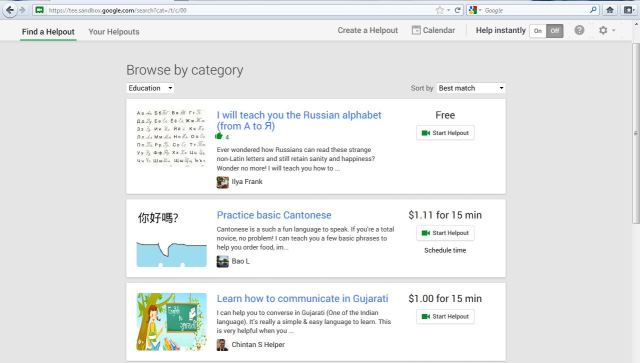
Â
Part of the reason Amazon has sprinted out to such a commanding lead in the e-commerce market is its growing network of fulfillment centers and distribution warehouses, which allow it to produce that magic, online retail bullet of low prices, convenience and speedy delivery. Without a fulfillment network, Google’s own local shopping ambitions seem to be taking a different shape. With Helpouts, Google, like eBay appears to be leaning into the territory of collaborative consumption marketplaces like, say, Zaarly, TaskRabbit and Live Ninja.
According to our source, Helpouts, like these startups before it, will cover a range of categories, including computers, education, food, health, hobbies and repair. One can then imagine services on Helpouts ranging from health consultations and fitness classes to appliance repair support and cooking lessons.
Google has also apparently partnered with a number of brands during internal testing, including One Medical Group, Sears, Weight Watchers and Alliance Frances, for example. At launch, the platform will also reportedly include an array of individual merchants and instructors as well, from yoga gurus to fitness teachers — all of whom will be able to offer both free and paid services to consumers via Helpouts.
According to our sources, with Helpouts, Google is looking to remove some of the barriers that have traditionally stood in the way of the seamless delivery of live services. For example, using Helpouts, a Spanish tutor from Argentina could offer language training to students in Japan, while a Yoga instructor in New York would be able to provide classes to a stay-at-home mom in Wyoming and an appliance repair shop could walk a customer through fixing a broken fan in their laptop — with an Internet connection being the only requirement.
Under the new, “One Google†Era, the company has begun to prioritize a greater collaboration or interrelationship between its products. With Helpouts, one could also imagine how the platform can act as a logical extension of Google’s core search and ads business. For example, customers could connect to retailers and manufacturers to get recommendations and advice on product purchases — or receive guidance on how to set up their products.
This could work to shore up a nagging gap for Google: When it comes to product searches, people no longer turn to Google. It’s all about Amazon. It also wouldn’t be a stretch to imagine Helpouts connecting to YouTube to offer video or lesson playback or integrating with Google’s nerd glasses.
Â
According to our source, Helpouts, like these startups before it, will cover a range of categories, including computers, education, food, health, hobbies and repair. One can then imagine services on Helpouts ranging from health consultations and fitness classes to appliance repair support and cooking lessons.
Google has also apparently partnered with a number of brands during internal testing, including One Medical Group, Sears, Weight Watchers and Alliance Frances, for example. At launch, the platform will also reportedly include an array of individual merchants and instructors as well, from yoga gurus to fitness teachers — all of whom will be able to offer both free and paid services to consumers via Helpouts.
According to our sources, with Helpouts, Google is looking to remove some of the barriers that have traditionally stood in the way of the seamless delivery of live services. For example, using Helpouts, a Spanish tutor from Argentina could offer language training to students in Japan, while a Yoga instructor in New York would be able to provide classes to a stay-at-home mom in Wyoming and an appliance repair shop could walk a customer through fixing a broken fan in their laptop — with an Internet connection being the only requirement.
Under the new, “One Google†Era, the company has begun to prioritize a greater collaboration or interrelationship between its products. With Helpouts, one could also imagine how the platform can act as a logical extension of Google’s core search and ads business. For example, customers could connect to retailers and manufacturers to get recommendations and advice on product purchases — or receive guidance on how to set up their products.
This could work to shore up a nagging gap for Google: When it comes to product searches, people no longer turn to Google. It’s all about Amazon. It also wouldn’t be a stretch to imagine Helpouts connecting to YouTube to offer video or lesson playback or integrating with Google’s nerd glasses.
Â
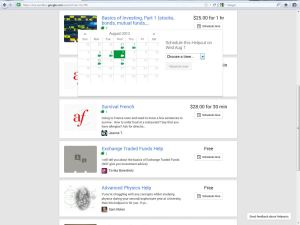
Â
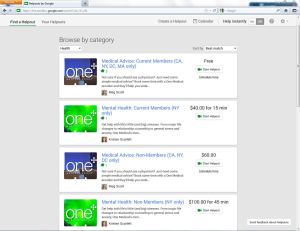 Of course, as with any Google product launch, life could be getting a little bit tougher for its smaller (and startup-y) competitors. There is a long list of businesses that either parallel or would directly compete with some part of Helpouts, whether it be LiveNinja, PowWow (which is, believe it or not, founded by a former Googler), Live Moka, InstaEdu, Shmoop and, perhaps less directly, platforms like Angie’s List, Udemy, Skillshare, TaskRabbit, CreativeLive and Curious. Though, admittedly, some of these overlap more than others. When it comes to big data or resources that can be thrown into curating a service offering like this, startups are bringing a knife to a gun fight. Firstly, there’s plenty of room for a more polished, higher-quality product in this space and, secondly, Google has video tech that’s already been widely adopted by individuals and businesses. Not to mention, most startups can’t hold a candle to Google’s marketing machine.
Of course, as with any Google product launch, life could be getting a little bit tougher for its smaller (and startup-y) competitors. There is a long list of businesses that either parallel or would directly compete with some part of Helpouts, whether it be LiveNinja, PowWow (which is, believe it or not, founded by a former Googler), Live Moka, InstaEdu, Shmoop and, perhaps less directly, platforms like Angie’s List, Udemy, Skillshare, TaskRabbit, CreativeLive and Curious. Though, admittedly, some of these overlap more than others. When it comes to big data or resources that can be thrown into curating a service offering like this, startups are bringing a knife to a gun fight. Firstly, there’s plenty of room for a more polished, higher-quality product in this space and, secondly, Google has video tech that’s already been widely adopted by individuals and businesses. Not to mention, most startups can’t hold a candle to Google’s marketing machine.Furthermore, according to our sources, Google has been building Helpouts in complete secrecy — well, until now — and few employees at the company were initially aware of the product, which has been developed by a team of two dozen engineers over the past year. Other than that, details are hazy. Perhaps Sergey and his secretive Google X unit are responsible. Only time will tell.
Â
 When it comes to big data or resources that can be thrown into curating a service offering like this, startups are bringing a knife to a gun
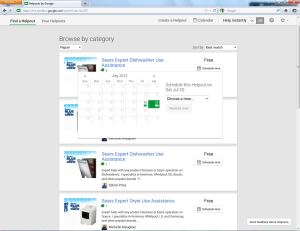 fight. Firstly, there’s plenty of room for a more polished, higher-quality product in this space and, secondly, Google has video tech that’s already been widely adopted by individuals and businesses. Not to mention, most startups can’t hold a candle to Google’s marketing machine.
fight. Firstly, there’s plenty of room for a more polished, higher-quality product in this space and, secondly, Google has video tech that’s already been widely adopted by individuals and businesses. Not to mention, most startups can’t hold a candle to Google’s marketing machine.Furthermore, according to our sources, Google has been building Helpouts in complete secrecy — well, until now — and few employees at the company were initially aware of the product, which has been developed by a team of two dozen engineers over the past year. Other than that, details are hazy. Perhaps Sergey and his secretive Google X unit are responsible. Only time will tell.
In the meantime, some may be wondering, if Helpouts is destined for YouTube (or at least HangOuts)-level adoption, or whether this is more of an experiment and it will just end up suffering the same fate as Reader or the geek-adored Wave. It’s not totally clear just how much marketing spend Google is going to dish out or whether it intends for this to have mass-appeal, but based on what we’re seeing, I would lean towards the affirmative.
Furthermore, while the type and date of the product’s rollout remain unclear, we’ve heard from sources that Helpouts was recently the subject of a company-wide meeting, which suggests that at least a few Googlers are taking this seriously.
Stay tuned for more.
By Rip Empson
DealerNet Services
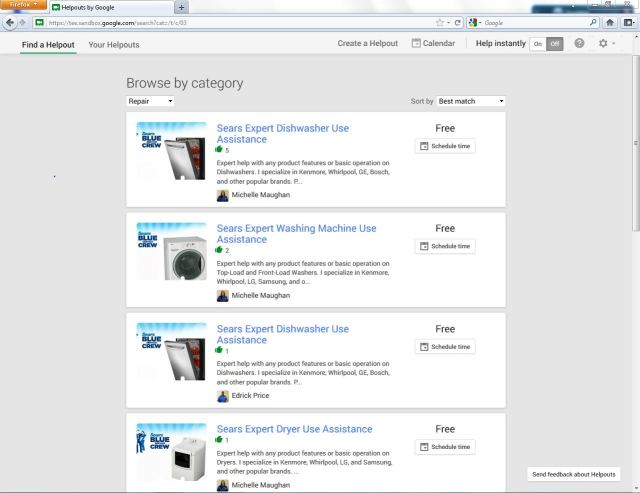

Google SEO SECRETS: you only need 9 back links
(Without Adwords)
WATCH THIS VIDEO:
http://dealernetservicesonline.biz/3/post/2013/07/google-seo-secrets-you-only-need-9-back-links.html
Â
WATCH THIS VIDEO:
http://dealernetservicesonline.biz/3/post/2013/07/google-seo-secrets-you-only-need-9-back-links.html
Â
Â
Â
Google+ Continues To Dominate LinkedIn and Twitter, Could catch up to Facebook
Tags:
(Posted on Jul 10, 2013 at 04:10PM )

You may not be using Google+, but your friends probably are.If they’re not hanging out and posting photos of cute puppies and sunsets, there’s a good chance they’re using Google+ to log in to various web sites — and
 increasingly, they’re also clicking the +1 button to share those sites. In fact, it’s the clear number two social network according to a variety of measurements.
A new study commissioned by Janrain shows that, of the people who use social networks to log in to other websites, almost half (46 percent) use Facebook. But Google+ is in a strong second place, with 34 percent of social logins. (Janrain makes tools to help web developers use social network logins on their sites.)
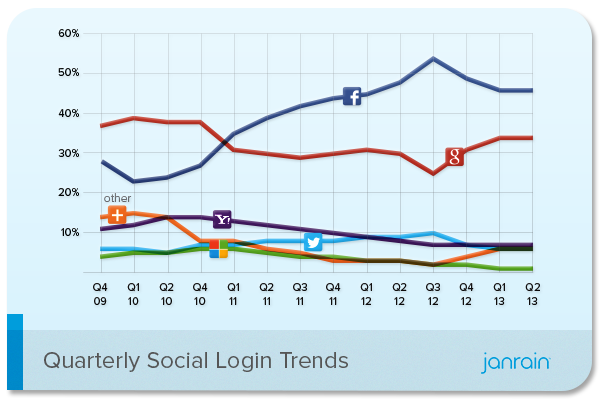
That bolsters the claim that Google+, despite its late start, is solidifying its position as the number 2 social network after Facebook.
In a distant third place: Yahoo, with just 7 percent of social logins; and Twitter, with 6 percent.
Google+ launched to a limited number of users in June, 2011, and more widely in September of that year. In the two years since then, it has zoomed past social networks that were years ahead and had hundreds of millions of users already: LinkedIn, Twitter, and a handful of Chinese social networks.
Google+ now has more than 500 million registered users and 343 million active users, according to an independent study by GlobalWebIndex from December, 2012.
Facebook is twice as big, claiming over a billion registered users, while GlobalWebIndex estimates Facebook has almost 700 million active
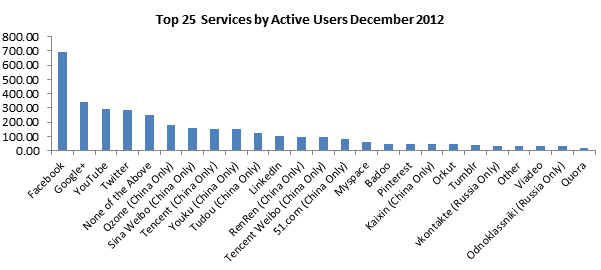
But Google+ is growing faster, according to some measurements. It’s holding steady on social logins, according to Janrain’s data, growing just a fraction of a percent in Q2 2013. (Facebook sharing also stayed at roughly the same level — see the graph above.)
But sharing on both networks is increasing rapidly — only it’s growing much faster on Google+. People who use Facebook are sharing 10 percent more each month, in aggregate, while Google+ shares (aka +1s) are growing by 19 percent per month, according to a recent estimate by Searchmetrics, which tracks social network data.
At that rate, Searchmetrics estimated, Google will surpass Facebook by May 2016, at which time its users will generate over 1,096 billion +1s per month (yes, more than a trillion) while Facebook users will generate just 849 billion shares per month.
However you look at it — registered users, active users, social logins, or shares — Google+ is a surprisingly serious second. And it may even be a contender for the #1 spot in a few years.
Now if I could only find some people to hang out with on Google+.
Dylan Tweney
CALENDAR
CATEGORIES
TAGS
TWITTER POSTS
CALENDAR
No IMGY selected.
- powered by
- One Big Broadcast
- creative by
- WebStager
© 2025 One Big Broadcast | All rights reserved
